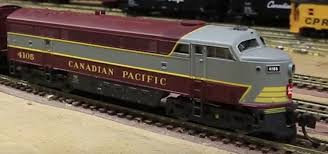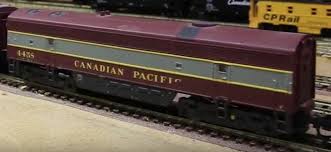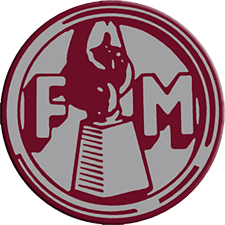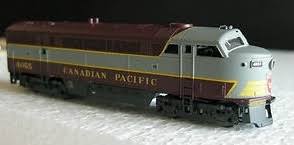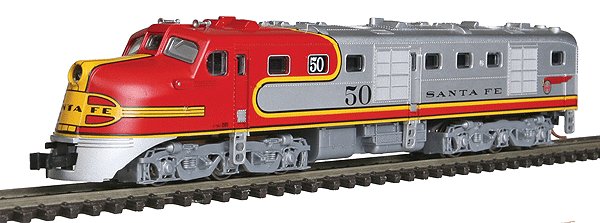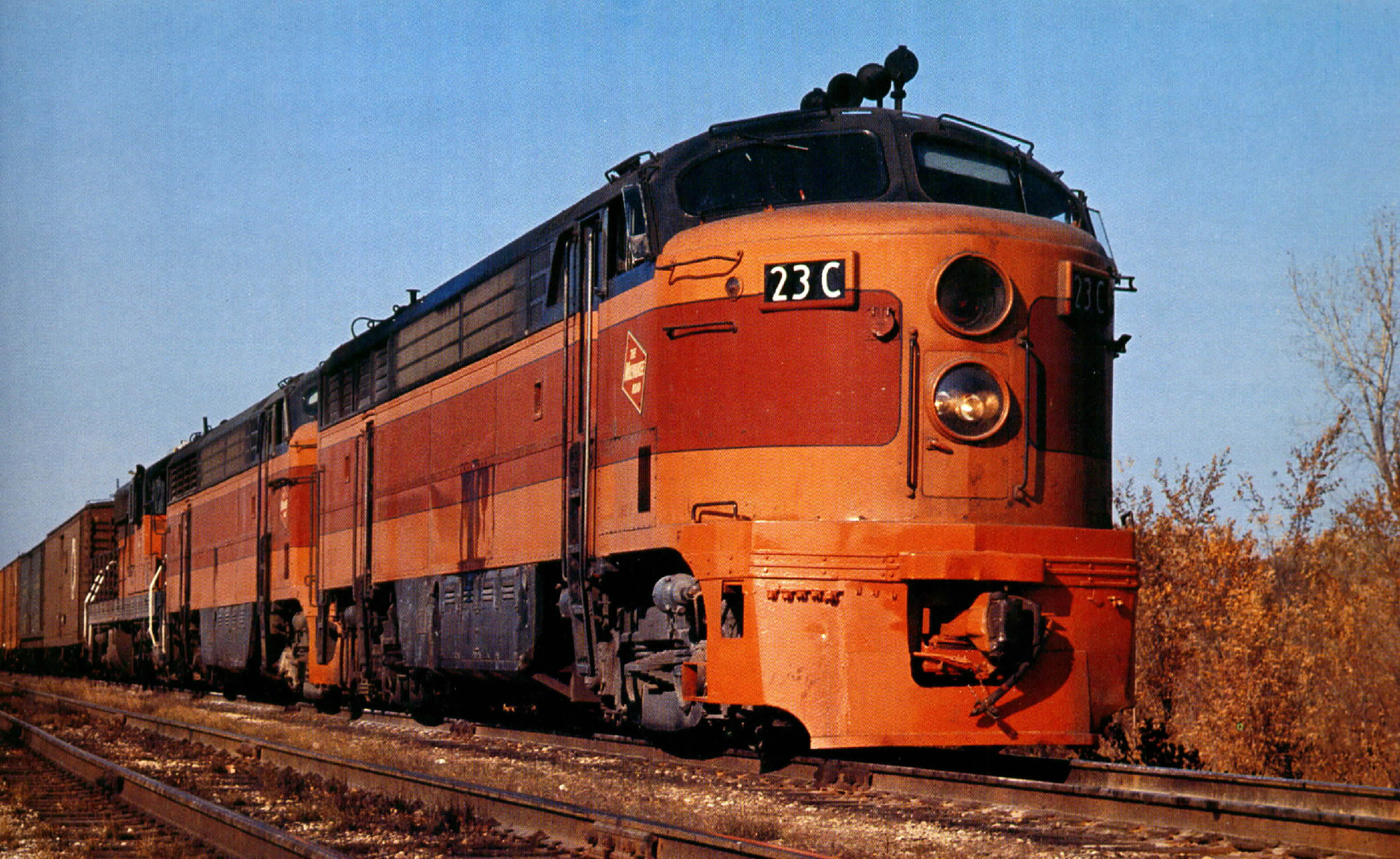Specific Item Information: CFA16-4+CFB16-4
Model Information: Model introduced in 2001 (with Rapido couplers and a dummy knuckle front coupler) and re-run in 2006 with Accumate knuckle couplers.
It re-used the same chassis structure introduced by Life-Like for its 2000 Alco FA-1/FB-1.
The 2001 run was sold in A/B pairs, both engines being powered. The 2006 run was available either in A/B pair or A singleton.
Features:
- Modern split-frame design.
- Directional LED Headlights on A units
- 8 Wheel electrical Pick-Up with Heavy Metal Chassis
- Five-Pole, Skew Wound Armiture motor w/dual machined flywheels
It re-used the same chassis structure introduced by Life-Like for its 2000 Alco FA-1/FB-1.
The 2001 run was sold in A/B pairs, both engines being powered. The 2006 run was available either in A/B pair or A singleton.
Features:
- Modern split-frame design.
- Directional LED Headlights on A units
- 8 Wheel electrical Pick-Up with Heavy Metal Chassis
- Five-Pole, Skew Wound Armiture motor w/dual machined flywheels
DCC Information: The initial run of 2001 had no provision for DCC. Examples of installation of a wired decoder are available on TCS website, as well as on N Scale DCC Decoder Installs blog by our fellow curator Brad Myers.
On the second run of 2006, the chassis was modified to become DCC-Ready with contacts available on a PCB. Would rather qualify as DCC Friendly, as some wiring is still required given the lack of choice of drop-in decoders for this model.
The only available drop-in decoder we have found is a sound decoder by MRC:
- MRC 1660: N Scale Drop in DCC Sound Decoder for Life-Like C-Liner Locomotive
On the second run of 2006, the chassis was modified to become DCC-Ready with contacts available on a PCB. Would rather qualify as DCC Friendly, as some wiring is still required given the lack of choice of drop-in decoders for this model.
The only available drop-in decoder we have found is a sound decoder by MRC:
- MRC 1660: N Scale Drop in DCC Sound Decoder for Life-Like C-Liner Locomotive
Prototype History: The Consolidated line, or C-line, was a series of diesel-electric railway locomotive designs produced by Fairbanks-Morse and its Canadian licensee, the Canadian Locomotive Company. Individual locomotives in this series were commonly referred to as “C-liners”. A combined total of 165 units (123 cab-equipped lead A units and 42 cabless booster B units) were produced by F-M and the CLC between 1950 and 1955.
The C-Liners replaced FM's earlier cab model the Erie-Built, which proved only marginally successful at best. The updated version of FM's cab locomotives did not feature a carbody nearly as elegant as the former, which sported a European look. It was offered for either passenger or freight (with four or five axles) service and intended to compete against Electro-Motive's (EMD) popular E and F series as well as Alco's FA and PA models. Unfortunately, the C-Liners saw about the same level of success as the Erie-Builts and FM canceled the line after only a few years of production.
All of the designs were based on a common 56 ft 3 in (17.15 m) carbody, but the customer could choose cab or booster units equipped with 1,600 hp (1.19 MW), 2,000 hp (1.49 MW), or 2,400 hp (1,800 kW) opposed piston engine prime movers. Each option was also offered in both passenger and freight configurations.
All freight units, and the CLC-built Model CPA/B-16-4 were designed with a B-B wheel arrangement, while passenger units (in addition to having different gearing) featured an unusual B-A1A wheel configuration, as the rear truck required an extra unpowered axle to help distribute the weight of the steam generator.
The models produced comprise: CFA-16-4 (cabs) and CFB-16-4 (cabless boosters), CFA-20-4 (cabs) and CFB-20-4 (cabless boosters), CPA-20-5 (cabs), CPA-24-5 (cabs), CPA-16-4 (cabs), CPA-16-5 (cabs) and CPB-16-5 (cabless boosters).
Using the CFA16-4 as an example the "C" referred to cab unit, "F" listed it for freight service, "A" was a designation for A unit, "16" was short for 1,600 hp, and "4" was the number of axles it carried.
From Wikipedia
Read more on American-Rails.com
The C-Liners replaced FM's earlier cab model the Erie-Built, which proved only marginally successful at best. The updated version of FM's cab locomotives did not feature a carbody nearly as elegant as the former, which sported a European look. It was offered for either passenger or freight (with four or five axles) service and intended to compete against Electro-Motive's (EMD) popular E and F series as well as Alco's FA and PA models. Unfortunately, the C-Liners saw about the same level of success as the Erie-Builts and FM canceled the line after only a few years of production.
All of the designs were based on a common 56 ft 3 in (17.15 m) carbody, but the customer could choose cab or booster units equipped with 1,600 hp (1.19 MW), 2,000 hp (1.49 MW), or 2,400 hp (1,800 kW) opposed piston engine prime movers. Each option was also offered in both passenger and freight configurations.
All freight units, and the CLC-built Model CPA/B-16-4 were designed with a B-B wheel arrangement, while passenger units (in addition to having different gearing) featured an unusual B-A1A wheel configuration, as the rear truck required an extra unpowered axle to help distribute the weight of the steam generator.
The models produced comprise: CFA-16-4 (cabs) and CFB-16-4 (cabless boosters), CFA-20-4 (cabs) and CFB-20-4 (cabless boosters), CPA-20-5 (cabs), CPA-24-5 (cabs), CPA-16-4 (cabs), CPA-16-5 (cabs) and CPB-16-5 (cabless boosters).
Using the CFA16-4 as an example the "C" referred to cab unit, "F" listed it for freight service, "A" was a designation for A unit, "16" was short for 1,600 hp, and "4" was the number of axles it carried.
From Wikipedia
Read more on American-Rails.com
Road Name History: The Canadian Pacific Railway (CPR), formerly also known as CP Rail (reporting mark CP) between 1968 and 1996, is a historic Canadian Class I railroad incorporated in 1881. The railroad is owned by Canadian Pacific Railway Limited (TSX: CP, NYSE: CP), which began operations as legal owner in a corporate restructuring in 2001.
Headquartered in Calgary, Alberta, it owns approximately 23,000 kilometres (14,000 mi) of track all across Canada and into the United States, stretching from Montreal to Vancouver, and as far north as Edmonton. Its rail network also serves major cities in the United States, such as Minneapolis, Milwaukee, Detroit, Chicago, and New York City.
The railway was originally built between Eastern Canada and British Columbia between 1881 and 1885 (connecting with Ottawa Valley and Georgian Bay area lines built earlier), fulfilling a promise extended to British Columbia when it entered Confederation in 1871. It was Canada's first transcontinental railway, but currently does not reach the Atlantic coast. Primarily a freight railway, the CPR was for decades the only practical means of long-distance passenger transport in most regions of Canada, and was instrumental in the settlement and development of Western Canada. The CP became one of the largest and most powerful companies in Canada, a position it held as late as 1975. Its primary passenger services were eliminated in 1986, after being assumed by Via Rail Canada in 1978. A beaver was chosen as the railway's logo because it is the national symbol of Canada and was seen as representing the hardworking character of the company.
The company acquired two American lines in 2009: the Dakota, Minnesota and Eastern Railroad and the Iowa, Chicago and Eastern Railroad. The trackage of the ICE was at one time part of CP subsidiary Soo Line and predecessor line The Milwaukee Road. The combined DME/ICE system spanned North Dakota, South Dakota, Minnesota, Wisconsin, Nebraska and Iowa, as well as two short stretches into two other states, which included a line to Kansas City, Missouri, and a line to Chicago, Illinois, and regulatory approval to build a line into the Powder River Basin of Wyoming. It is publicly traded on both the Toronto Stock Exchange and the New York Stock Exchange under the ticker CP. Its U.S. headquarters are in Minneapolis.
After close of markets on November 17, 2015, CP announced an offer to purchase all outstanding shares of Norfolk Southern Railway, at a price in excess of the US$26 billion capitalization of the United States-based railway. If completed, this merger of the second and fourth oldest Class I railroads in North America would have formed the largest single railway company on that continent, reaching from the Pacific coast to the Atlantic coast to the Gulf Coast. The merger effort was abandoned by Canadian Pacific on April 11, 2016, after three offers were rejected by the Norfolk Southern board.
Read more on Wikipedia and on Canadian Pacific official website.
Headquartered in Calgary, Alberta, it owns approximately 23,000 kilometres (14,000 mi) of track all across Canada and into the United States, stretching from Montreal to Vancouver, and as far north as Edmonton. Its rail network also serves major cities in the United States, such as Minneapolis, Milwaukee, Detroit, Chicago, and New York City.
The railway was originally built between Eastern Canada and British Columbia between 1881 and 1885 (connecting with Ottawa Valley and Georgian Bay area lines built earlier), fulfilling a promise extended to British Columbia when it entered Confederation in 1871. It was Canada's first transcontinental railway, but currently does not reach the Atlantic coast. Primarily a freight railway, the CPR was for decades the only practical means of long-distance passenger transport in most regions of Canada, and was instrumental in the settlement and development of Western Canada. The CP became one of the largest and most powerful companies in Canada, a position it held as late as 1975. Its primary passenger services were eliminated in 1986, after being assumed by Via Rail Canada in 1978. A beaver was chosen as the railway's logo because it is the national symbol of Canada and was seen as representing the hardworking character of the company.
The company acquired two American lines in 2009: the Dakota, Minnesota and Eastern Railroad and the Iowa, Chicago and Eastern Railroad. The trackage of the ICE was at one time part of CP subsidiary Soo Line and predecessor line The Milwaukee Road. The combined DME/ICE system spanned North Dakota, South Dakota, Minnesota, Wisconsin, Nebraska and Iowa, as well as two short stretches into two other states, which included a line to Kansas City, Missouri, and a line to Chicago, Illinois, and regulatory approval to build a line into the Powder River Basin of Wyoming. It is publicly traded on both the Toronto Stock Exchange and the New York Stock Exchange under the ticker CP. Its U.S. headquarters are in Minneapolis.
After close of markets on November 17, 2015, CP announced an offer to purchase all outstanding shares of Norfolk Southern Railway, at a price in excess of the US$26 billion capitalization of the United States-based railway. If completed, this merger of the second and fourth oldest Class I railroads in North America would have formed the largest single railway company on that continent, reaching from the Pacific coast to the Atlantic coast to the Gulf Coast. The merger effort was abandoned by Canadian Pacific on April 11, 2016, after three offers were rejected by the Norfolk Southern board.
Read more on Wikipedia and on Canadian Pacific official website.
Brand/Importer Information:  Life-Like Products LLC (now Life-Like Toy and Hobby division of Wm. K. Walthers) was a manufacturer of model railroad products and was based in Baltimore, Maryland.
Life-Like Products LLC (now Life-Like Toy and Hobby division of Wm. K. Walthers) was a manufacturer of model railroad products and was based in Baltimore, Maryland.
It was founded in the 1950s by a company that pioneered extruded foam ice chests under the Lifoam trademark. Because ice chests are a summer seasonal item, the company needed a way to keep the factory operating year round. As model railroading was becoming popular in the post-war years, they saw this as an opportunity and so manufactured extruded foam tunnels for model trains. Over the years, Life-Like expanded into other scenery items, finally manufacturing rolling stock beginning in the late 1960s. At some point in the early 1970s, Life-Like purchased Varney Inc. and began to produce the former Varney line as its own.
The Canadian distributor for Life-Like products, Canadian Hobbycraft, saw a missing segment in market for Canadian model prototypes, and started producing a few Canadian models that were later, with a few modifications, offered in the US market with US roadnames.
In 2005, the company, now known as Lifoam Industries, LLC, decided to concentrate on their core products of extruded foam and sold their model railroad operations to Wm. K. Walthers.
In June 2018, Atlas and Walthers announced to have reached an agreement under which all Walthers N scale rolling stock tooling, including the former Life-Like tooling, will be purchased by Atlas.
Read more on Wikipedia and The Train Collectors Association.

It was founded in the 1950s by a company that pioneered extruded foam ice chests under the Lifoam trademark. Because ice chests are a summer seasonal item, the company needed a way to keep the factory operating year round. As model railroading was becoming popular in the post-war years, they saw this as an opportunity and so manufactured extruded foam tunnels for model trains. Over the years, Life-Like expanded into other scenery items, finally manufacturing rolling stock beginning in the late 1960s. At some point in the early 1970s, Life-Like purchased Varney Inc. and began to produce the former Varney line as its own.
The Canadian distributor for Life-Like products, Canadian Hobbycraft, saw a missing segment in market for Canadian model prototypes, and started producing a few Canadian models that were later, with a few modifications, offered in the US market with US roadnames.
In 2005, the company, now known as Lifoam Industries, LLC, decided to concentrate on their core products of extruded foam and sold their model railroad operations to Wm. K. Walthers.
In June 2018, Atlas and Walthers announced to have reached an agreement under which all Walthers N scale rolling stock tooling, including the former Life-Like tooling, will be purchased by Atlas.
Read more on Wikipedia and The Train Collectors Association.
Item created by: Alain LM on 2018-07-07 08:17:15. Last edited by CNW400 on 2020-05-16 23:31:29
If you see errors or missing data in this entry, please feel free to log in and edit it. Anyone with a Gmail account can log in instantly.
If you see errors or missing data in this entry, please feel free to log in and edit it. Anyone with a Gmail account can log in instantly.


